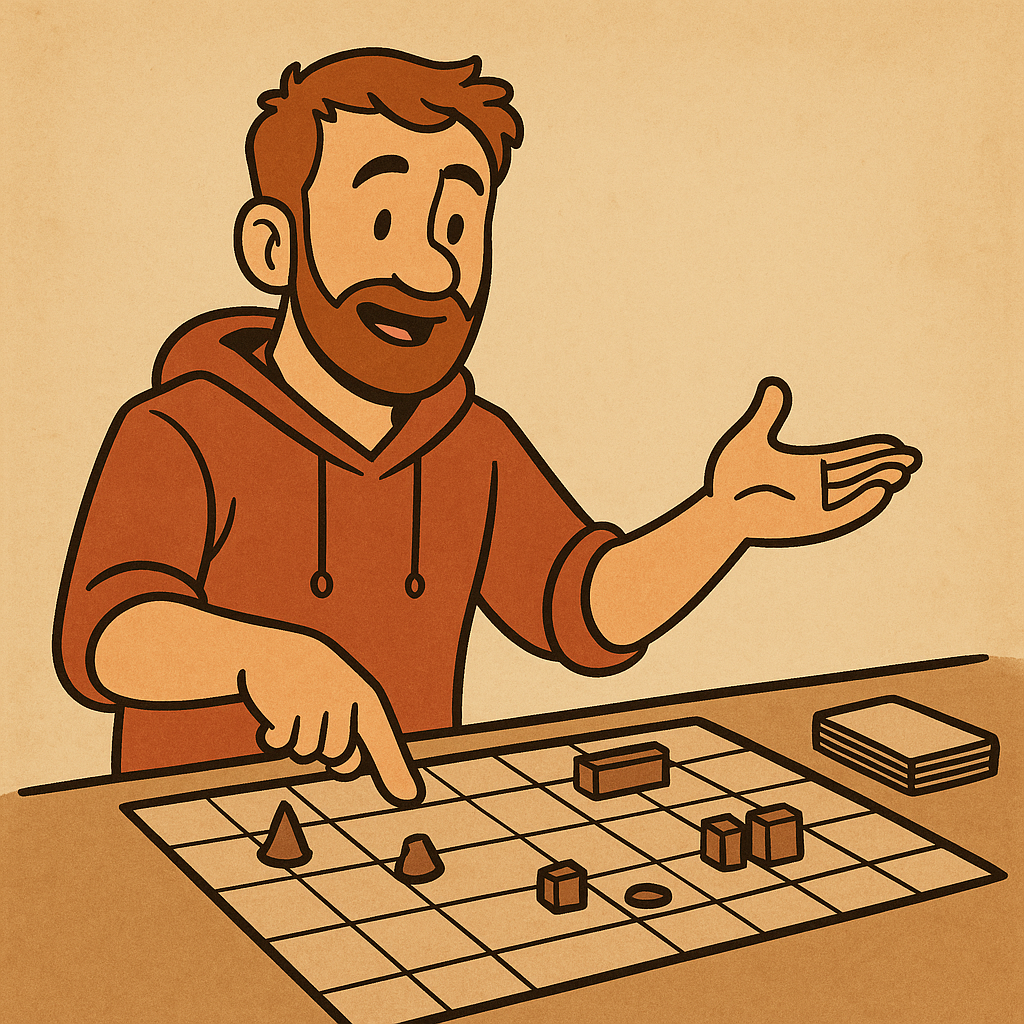Tips for Explaining Complex Rules and Keeping Your Group Engaged—Even During the Tutorial
You open the box. Gorgeous components, sleek board layout, cards brimming with possibility.
You know this game is going to be amazing.
Then you open the rulebook—and suddenly you’re reading an arcane incantation designed to summon confusion instead of strategy. Now it’s your job to teach five friends the rules… and not watch them mentally exit the room five minutes in.
Teaching board games is a sacred art. It’s the arcane ritual that determines whether your game night launches like a rocket or crashes into a swamp of glazed-over eyes, misunderstood phases, and passive-aggressive side chats.
Fear not. Today, on RPGInquisitor, we’re unlocking the Ten Secrets of Teaching Games Like a Tabletop God—with humor, structure, and enough wisdom to make your next tutorial a masterpiece.

🧠 1. Know the Game Before You Teach It
Sounds obvious, right?
And yet…
Nothing kills momentum faster than “Wait, let me check something,” followed by three minutes of flipping through a rulebook while players fidget, whisper, or slip into phone-scrolling purgatory.
Don’t Just Read—Rehearse
Before game night:
- Watch a short playthrough or overview video.
- Set up the game by yourself and play 1–2 sample rounds.
- Learn the flow: turn structure, win condition, and common actions.
- Try to explain it out loud, even to an empty room.
If you understand why each rule exists, not just what it does, you’ll teach it more intuitively.
Teaching is performance. Rehearsing makes you the confident bard of game night.
🧩 2. Begin With the Big Picture—Not the Pieces
Don’t start by explaining every token, board zone, or exception.
That’s like starting a story with the 5th chapter and hoping people care.
Instead, explain:
- The goal of the game
“In Terraforming Mars, you’re mega-corps trying to make Mars habitable by raising temperature, oxygen, and building cities.”
- What players do on a turn
“You’ll take two actions per turn—like playing cards, raising temperature, building, etc.”
- How the game ends
“Once Mars is fully terraformed, we total victory points from cards, cities, and milestones.”
This gives players a narrative context. They now understand where they’re headed—and why it matters.
Once they know the what and the why, you can introduce the how.
🪜 3. Explain the Game in Layers
Resist the urge to dump every mechanic upfront. Instead, teach in layers, like this:
Layer 1: Core loop
- What players do every turn
- Basic types of actions
- How turns pass and rounds end
Layer 2: Winning
- What scores points
- What causes the game to end
Layer 3: Finer mechanics
- How resources or economies work
- Phases of player upkeep
- Player abilities or asymmetries
Layer 4: Edge cases and exceptions
- Tiebreakers
- Rare card effects
- Situational bonuses
Don’t explain every exception before it comes up. Let gameplay introduce rules organically.
You’re teaching a flow, not a manual.
🎯 4. Use the Board as a Visual Aid
Point. Touch. Move. Circle with your hand like a wizard.
Don’t lecture in a vacuum.
While you talk, use the board, pieces, and player cards as visual anchors.
- When you mention a resource, point to it.
- When you describe a player action, demonstrate it.
- Use sample turns with open info to walk through decisions.
This taps into visual memory, and helps people retain mechanics by associating them with physical elements.
A player who doesn’t understand “drafting mechanics” might instantly get it when you shuffle and pass cards live.
Bonus: this breaks up the verbal flow and keeps eyes on the table—not on phones.
👥 5. Always Teach With Player POV in Mind
Teach from the player’s perspective, not the rulebook’s.
Avoid saying:
“First, draw cards equal to hand limit unless it’s Phase B and the research bonus is active, then resolve the card queue if…”
Instead say:
“On your turn, you’ll draw cards and pick one to play. Most cards affect the board or earn you points in different ways—like growing trees, building tech, or nuking forests.”
Players aren’t absorbing legalese. They’re imagining what they get to do.
Teach actions like verbs—“build,” “steal,” “expand,” “harvest”—not game jargon like “resolve” or “trigger.”
Make it sound like fun. Because it is.
🧩 6. Give a Sample Turn—Then Let Players Try
Before actual play begins, run through one or two turns as a mock demonstration. Open hands, no pressure, explain as you go.
Example:
“Okay, it’s Lara’s mock turn. She’ll draw 2 cards, choose one, pay energy to play it, then move her ship two spaces. See how she just got two credits for ending on the trading hub?”
Mock turns do three things:
- Reinforce flow
- Answer unspoken questions
- Reduce fear of doing it wrong
Then let them jump into the game. Trust me—learning happens way faster by doing.
🧠 7. Be Honest About the “Tricky” Bits
Every game has them.
Maybe the scoring is convoluted. Maybe one card type works differently. Maybe the third round introduces a new phase.
Call this out clearly, and explain that it will make more sense later.
“Combat seems weird at first, but once you’ve seen it once, it’ll click. I’ll walk you through the first battle.”
This does two things:
- Calms anxiety
- Makes players more forgiving of temporary confusion
Also, show them where that rule lives in the rulebook. This makes follow-up questions smoother.
📉 8. Manage Table Energy During the Teach
People have limited attention spans—especially before they’ve had fun.
Here’s how to manage that:
- Keep the rule teach under 15 minutes, max (ideally 7–10 for most games).
- Check in visually. Are they nodding, fidgeting, glazing over?
- Use humor and questions to reset attention.
- If you sense confusion, stop and reset a concept.
Bonus move: keep snacks, water, and breaks accessible. Physical comfort equals better attention.
If someone checks out mid-teach, don’t call them out. Re-engage them with open-ended questions when you demo a turn.
🎭 9. Teach With Confidence and Flexibility
You do not need to be perfect.
You’ll forget something. A rule will come up mid-game. You’ll miss an edge case. That’s fine.
What matters is that you teach with confidence and clarity, and that you’re honest about what you do or don’t know.
“I think this rule works like this—but let’s double-check between rounds.”
Confidence is contagious. If you trust the game will be fun, others will too.
Just avoid being defensive or overcorrecting. Players don’t want a rules robot—they want a human storyteller guiding them into the experience.
🧪 10. After 1–2 Rounds, Pause for Questions
The best teach isn’t finished once the game starts.
After one or two rounds, pause. Ask:
“How’s everyone feeling? Want to review anything?”
Players now have context for your answers. They’ve had turns. They’ve made decisions. They know what to ask.
This is the moment most “aha!” moments happen.
Encourage questions. Clarify anything that still feels shaky.
Tip: You can even recap core rules out loud to reinforce confidence. “Remember, draw—play—move—resolve. That’s the loop.”
🎉 Bonus Tips for Teaching Like a Pro
Use Cheat Sheets
Quick-reference player aids reduce confusion and rulebook hunting.
Anticipate First-Timer Mistakes
Point out common errors before they happen. “Don’t forget, you can’t attack until you’ve built an army.”
Teach by Comparison
If someone knows another game, frame yours in those terms:
“It’s like Catan, but instead of trading wheat, you’re trading souls.”
Don’t Gatekeep Strategy
Feel free to offer a little guidance at the start:
“If you want points early, focusing on economy helps.”
Helping someone enjoy the game doesn’t spoil it—it builds momentum.
🧠 Real Talk: Why This Matters
When you teach a game well, you’re doing more than instructing.
You’re:
- Setting the tone for the entire night
- Respecting people’s time and energy
- Building confidence and curiosity
- Giving permission to play boldly
Most importantly?
You’re reminding people that games are about people first—not rules, boards, or victory points.
That’s what keeps them coming back.
💬 Final Summary: How to Teach Like a Legend
| Step | What You Do |
|---|---|
| Know It | Rehearse before teaching |
| Frame It | Start with goal + core loop |
| Layer It | Teach mechanics in digestible chunks |
| Show It | Use visual aids and mock turns |
| Feel It | Match the room’s energy and mood |
| Adapt | Be flexible, pause, and adjust as needed |
| Lead | Be confident, generous, and encouraging |
You don’t need to be a game designer or theater kid to teach well.
You just need a little prep, a lot of empathy, and the belief that everyone wants to have fun—they just need you to open the door.
Go forth, teacher of games.
And may your rules never cause yawns, only excitement.

